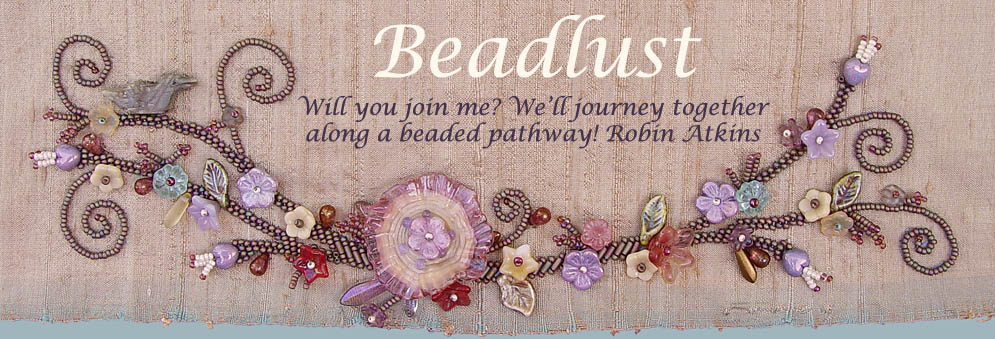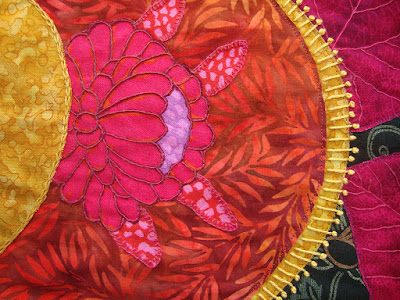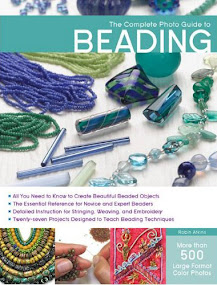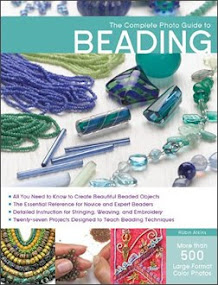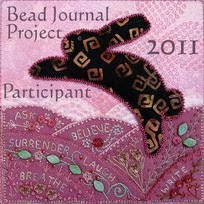When my brother, Thom Atkins, visited last fall, he showed me (and a few quilting buddies) his new method for designing and constructing "scrappy improv wall quilts," a technique that turned out to be a lot of fun for me, especially given my long history with an improvisational, intuitive approach to bead embroidery.
Basically, what we did was to empty our bags or boxes of scraps onto a large table and start pawing through them, pulling out ones that appealed to us at that moment. For me it was all about color - red, magenta, fuchsia, with hints of pink, golden-yellow, orange, lavender, and dark green. All of the fabrics were in my scrap box. We had two days of Thom's demonstrations and guidance. During that time, each of us in our small group produced a unique and very pleasing "piece" or "block," measuring roughly 18 x 21 inches, the size of a fat quarter.
One of my red scraps, cut in a nice arc at one end, was the start of it all because I liked the shape and the color. Next I picked up a small strip of yellow, and held it behind the arc of red. Ooooh! Nice enough to repeat. The scrap of orange/red batik was large enough to cut a similar arc, and the strip of yellow was long enough to go behind that one too. These two arcs formed the basis of my piece.
You can see the two arcs above; the lower right was the first. The yellow strip was only about 3" wide, not enough to go all the way around the arcs, but I cut two shapes that would echo the top of each of the arcs. I layered the remaining scraps from that on top of the arcs along the vertical edges of the design. Then I put a dark green scrap behind the arcs and the yellow, which set them off nicely. The rest was just filling to the edges of the quilt with more scraps, including fussy-cut leaves and flowers.
The next step was to glue it all together along the 1/4" seam overlap, working in layers from bottom to top, and cutting away the excess fabric from the underside after each piece is glued. Cutting away the excess fabric leaves a double layer of fabric only at the seams; the rest is a single layer. The glue is Elmer's School Glue, Disappearing Purple, as shown below. It is an organic stick glue, relatively easy to sew through, repositionable, (in case you change your mind), and purple when first applied, drying to transparent (so you can see where exactly you are putting it).
Thom's method is a type of raw edge applique, typically accomplished with heat-fusible web, such as "wonder under." The typical method, given a complex, layered design such as mine, would have resulted in a thick, stiff, multi-layer surface, which would be difficult to quilt, even with a machine. In Thom's method, there is no web, and in most places only one or two layers of fabric. Like all raw edge techniques, the raw edges must be sewn down, and the resulting quilts are not very suitable for bed quilts unless there is heavy stitching over the raw edges (for example, dense, zig-zag, machine stitching).
After gluing my original (shown above) quilt top, I assembled the quilt, using a spray glue to layer the backing, batting and top. The next step was to stitch along the "seams," the overlapping, glued edge of each piece. From there, it was up to each of us as to how to finish the quilt, perhaps with machine quilting, such as stippling or contour stitches, or perhaps with beading, all of which Thom does on his quilts.
A couple of months went by after getting to the unfinished stage shown above. I liked it, but didn't know what to do with it, until one day when I was at our Senior Center, getting foot care from a trained nurse who comes a couple times a week to help those who need it. Her treatment room, about the size of a walk-in closet, has no windows. Her client faces the door to the room, a plain, wooden door. "That door needs a quilt," I told her. The rest is history; my scrappy improv quilt, Eclipse, hangs there now.
Only first I had to finish it. Above is the finished quilt, Eclipse. Below I'll tell you some of the finishing steps and about how I transformed it from looking flat and ordinary to sharp and textured using embroidery embellishments. Please click on the photo so you can see the details!
You might have noticed that the finished quilt is longer (better suited for hanging on a door) than the original piece. That was a challenge, although less than you might expect, because Thom had demonstrated for us how he sometimes extends the size of his quilts. In short, I roughly planned out the addition, the mock-up shown below, then created it using the same process and scraps as the original piece.
I used fusible "tape" made for butt-joining pieces of batting, to add a new piece of batting to the bottom edge of batting on the original (upper) part of the quilt. The horizontal strip of striped fabric overlaps the two parts of the quilt and the joined batting underneath. As you can see below, I added a fussy-cut flower over the striped fabric to break up the horizontal strip and visually join the two parts.
Confession time... I'm not good at machine quilting, and don't even have a proper quilting foot for my old machine (1972 Pfaff). I tried stitching around the fussy cut flowers to secure the glued edges, but failed miserably. What to do? Ah, hand-sew with embroidery stitches and floss? Yes! It took a few tries, but eventually I found stitch and thread combinations that worked.
It looked so good that I decided to add stitching and knots to the yellow arcs next. Wow! That popped the eclipse look! In the photo below, you can see bits of all the embroidery stitches I added. Not only does the embroidery provide embellishment and emphasis, it also further quilts the piece. Click the photo to see the detail and better read the stitch identification.
Here are two more detail photos of the finished quilt (without the text boxes).
Lots of fun, and I like the results! Will I do another one? Well, right now I've finally returned to my hexie project, where I'm likely to remain for many months, but after that, scrappy improv may be just what I need!
Monday, January 15, 2018
Subscribe to:
Posts (Atom)
